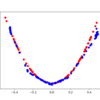Generative Adversarial Networks, or GANs for short, are effective at generating large high-quality images. Most improvement has been made to discriminator models in an effort to train more effective generator models, although less effort has been put into improving the generator models. The Style Generative Adversarial Network, or StyleGAN for short, is an extension to […]









